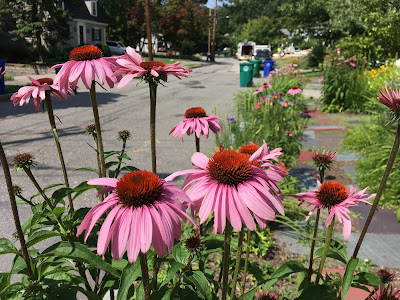 |
| Won't any leaf do? photo Toby Hudson |
Key to Tallamy’s call to plant natives is the assertion that most native insects are specialists that can only live off a small number of native plants. They’ve evolved over thousands of generations to be able to overcome the physiologic defenses of those plants, such as toxins that make leaves less appealing and digestible. They’ve synchronized their life cycles with those plants' and adapted to be able to sense them in their surroundings.
Is this true? The evolving evidence is that it’s more complicated. Some native insects really need particular native plants. We all know how monarch butterflies are suffering from decreased populations of native milkweeds, which their caterpillars need for food.
 |
| Monarch caterpillar chewing a milkweed leaf-photo Judy Gallagher |
But it turns out that some insects can cope with a broader selection of food plants, and some are already evolving to be able to live off nonnative plants. With short lifetimes, insects are able to evolve more quickly than longer-lived species such as humans.
It’s relevant to distinguish between leaf-eating insects and pollinators. An insect that chews leaves for food may truly need its chosen plant species to survive. An insect that collects pollen and nectar may choose from a variety of plants, including some nonnatives.
 |
| Eastern tiger swallowtail nectaring on nonnative butterfly bush |
Pollinators can deal with cultivars selected from native populations for new characteristics such as different flower colors or variegated foliage.
 |
| A bee doesn't object to this black-eyed Susan's ornamental petal colors |
Tallamy and his team are refining their theory with ongoing research on which plants are attractive to insects. At the Mt. Cuba Center, a Delaware botanic garden, they’re counting insects on a list of native trees and comparing them to counts on “nativars,” selected varieties of the same species that differ from the straight natives in characteristics such as growth habit, disease resistance, foliage color, and berry size. So far they’ve found that blueberry bushes with larger berries actually attracted more insects, disease-resistant American elms drew as many insects as the unimproved species that succumbed to Dutch elm disease, and trees with ornamental purple leaves were less popular with insects than trees with green leaves.
 |
| Disease-resistant elm selections are OK for native insects-photo Msact |
This kind of painstaking species-by-species research is what will provide gardeners with meaningful planting guidelines. There are other choices to make. Do we need plants from our local ecoregion, or will other North American natives do just as well? Will we choose organic or conventionally grown plants? Locally sourced or not? Will we use clones, plants that are produced asexually through cuttings or tissue culture?
So far I’m not feeling cramped by prioritizing native plants. There are plenty of appealing native shrubs and perennials I haven’t grown yet. I do prefer insecticide-free plants because of my concern about harm done by neonicotinoids. I’m looking forward to more information on “nativars” to guide future shopping trips.
 |
| Native purple coneflowers enliven a curb strip |
No comments:
Post a Comment